
GEOMETRIC AND FUNCTIONAL ANALYSIS
Scope & Guideline
Unveiling Innovations in Analysis and Geometry
Introduction
Aims and Scopes
- Geometric Analysis:
Studies the properties of geometric structures through the lens of analysis, including the examination of metrics, curvature, and geometric flows. - Functional Analysis:
Explores the properties of function spaces, operators, and their applications in various mathematical contexts, particularly in relation to geometric structures. - Topology and Geometry:
Investigates topological aspects of geometric objects, including homotopy, homology, and the study of manifolds and their properties. - Dynamics and Ergodic Theory:
Examines dynamical systems within geometric contexts, focusing on invariant measures, stability, and the long-term behavior of trajectories. - Algebraic Geometry:
Applies techniques from algebraic geometry to study complex structures and their applications in geometric analysis. - Differential Geometry:
Focuses on differentiable manifolds and the study of geometric structures defined by differential equations. - Geometric Group Theory:
Analyzes groups through their geometric properties, particularly in relation to spaces they act upon.
Trending and Emerging
- Geometric Group Theory:
An increase in studies related to geometric group theory, focusing on the interactions between group theory and geometric structures, has been observed, indicating a growing interest in this area. - Higher Dimensional Geometry:
Research on higher-dimensional manifolds and their properties is trending, showcasing the complexities and unique features that arise in higher dimensions. - Nonlinear Dynamics and Geometry:
There is a rising focus on nonlinear dynamics within geometric contexts, emphasizing the interplay between dynamical systems and geometric structures. - Spectral Theory on Geometric Spaces:
An emerging interest in the spectral properties of differential operators defined on various geometric objects is evident, reflecting a trend towards understanding the relationship between geometry and spectral theory. - Affine and Symplectic Geometry:
The exploration of affine and symplectic structures is gaining prominence, highlighting their applications in both pure and applied mathematics. - Metric Geometry and Its Applications:
The application of metric geometry to various mathematical problems is increasingly common, indicating a trend towards utilizing geometric insights in broader contexts.
Declining or Waning
- Classical Differential Equations:
There has been a noticeable decline in articles focused on classical differential equations and their geometric implications, as newer approaches and more complex systems gain traction. - Traditional Algebraic Techniques:
Research relying heavily on classical algebraic methods appears to be less frequent, suggesting a shift towards more geometric or computational approaches. - Elementary Topological Methods:
Simple topological techniques and results are being overshadowed by more advanced and nuanced methods, indicating a shift in the sophistication of research. - Local Analysis of Manifolds:
The focus on localized geometric analysis is diminishing, with a growing interest in global properties and their implications.
Similar Journals

MANUSCRIPTA MATHEMATICA
Exploring the Depths of Mathematical Knowledge.MANUSCRIPTA MATHEMATICA is an esteemed journal in the field of mathematics, published by Springer Heidelberg. Since its inception in 1969, this journal has served as a pivotal platform for disseminating high-quality research in a variety of mathematical disciplines, with a commitment to advancing knowledge and fostering collaboration among mathematicians. The journal holds a commendable impact factor and is ranked within the Q2 category for Mathematics (miscellaneous) in 2023, placing it favorably among its peers in terms of academic influence. Although open access options are not available, its rigorous peer-review process ensures that published articles maintain the highest academic standards. With a wide scope covering significant areas of general mathematics, MANUSCRIPTA MATHEMATICA not only caters to researchers and professionals seeking innovative insights but also serves as a valuable resource for students eager to deepen their understanding of mathematical theories and applications. For those looking to contribute to or stay informed about advancements in this dynamic field, the journal remains a crucial resource for literature and discourse.

COMMUNICATIONS IN ANALYSIS AND GEOMETRY
Pioneering Research in Mathematical SciencesCOMMUNICATIONS IN ANALYSIS AND GEOMETRY, published by INT PRESS BOSTON, INC, is a prestigious journal dedicated to advancing the fields of analysis, geometry, and statistics. With an impressive Q1 ranking in these categories for 2023, the journal stands out as a leading platform for cutting-edge research and scholarly discourse. Established in 1996, the journal has been instrumental in fostering a vibrant academic community that engages with both theoretical and applied aspects of mathematics. Despite not being an open-access journal, it continues to attract a wide readership owing to its rigorous peer-review process and high-impact publications. The journal's influence is further underlined by its respectable Scopus rankings, specifically in Geometry and Topology, where it ranks 40th out of 106, highlighting its significance in the scholarly landscape. Researchers, professionals, and students alike will find COMMUNICATIONS IN ANALYSIS AND GEOMETRY to be an invaluable resource for the latest findings and developments in these interconnected mathematical disciplines.
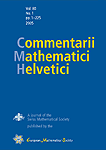
COMMENTARII MATHEMATICI HELVETICI
Advancing Mathematical Frontiers with Open Access InsightsCOMMENTARII MATHEMATICI HELVETICI, published by the EUROPEAN MATHEMATICAL SOCIETY, is a premier open-access journal in the field of mathematics, specifically categorized within the Q1 quartile of miscellaneous mathematics as of 2023. With an ISSN of 0010-2571 and an E-ISSN of 1420-8946, this esteemed journal has a rich history, having commenced its publication journey in 1929 and set to continue until at least 2024. Based in Germany, it provides a valuable platform for original research and significant advancement in mathematical theory and application, appealing to researchers, professionals, and students alike. The journal's commitment to open access since 2022 further enhances its accessibility and outreach, ensuring that cutting-edge mathematical developments are readily available to a global audience. Its Scopus ranking, which places it at the 165th position out of 399 in the general mathematics category (58th percentile), exemplifies its impact and relevance in the academic community.

Journal of Geometry
Connecting Mathematicians through Geometric InnovationJournal of Geometry, published by SPRINGER BASEL AG, is a prominent scholarly journal, ISSN 0047-2468 and E-ISSN 1420-8997, dedicated to the field of Geometry and Topology. Hailing from Switzerland, this journal has been a vital resource for researchers since its inception in 1971 and continues to contribute invaluable insights into geometric theories and applications through 2024. With a HIndex that reflects its academic impact, the journal currently ranks in the Q3 category for Geometry and Topology, placing it within the top half of publications in its field, as evidenced by its Scopus ranking of #71 out of 106 in Mathematics, Geometry, and Topology. The Journal of Geometry serves as a platform for original research, reviews, and special issues that address foundational and cutting-edge topics, making it an essential read for mathematicians, educators, and students alike. While it is not an open-access publication, the journal maintains accessibility through institutional subscriptions, ensuring that its significant contributions to geometry are readily available to the academic community.
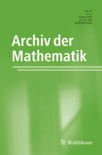
ARCHIV DER MATHEMATIK
Exploring the Depths of Mathematical InnovationARCHIV DER MATHEMATIK is a distinguished journal published by SPRINGER BASEL AG, renowned for its contributions to the field of mathematics. Established in 1948 and continuing its legacy through to 2024, the journal provides a platform for innovative research and scholarly articles that push the boundaries of mathematical theory and application. With an ISSN of 0003-889X and an E-ISSN of 1420-8938, it holds a reputable position within the academic community, reflected by its Q2 ranking in the 2023 Mathematics (Miscellaneous) category. Despite not being an open access publication, ARCHIV DER MATHEMATIK remains accessible to a global audience through various databases, ensuring the dissemination of high-quality research. The journal’s commitment to enhancing mathematical discourse makes it an essential resource for researchers, professionals, and students seeking to expand their understanding of this vital discipline.
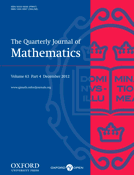
QUARTERLY JOURNAL OF MATHEMATICS
Connecting Scholars through Rigorous ResearchQuarterly Journal of Mathematics, published by Oxford University Press, stands as a pivotal resource for the mathematical community, focusing on a broad spectrum of topics in the field of mathematics. With its esteemed history dating back to 1930, this journal continues to foster innovative research and discussions, providing a platform for scholars to share their findings and insights. Although the journal currently holds a Q3 classification in mathematics (miscellaneous) and is ranked #207 among general mathematics publications in the Scopus database, its commitment to quality and rigorous peer review ensures that it remains relevant and insightful. Researchers, professionals, and students alike will find the Quarterly Journal of Mathematics an invaluable tool for advancing knowledge and understanding in various mathematical disciplines, making it an essential addition to any academic library.

JOURNAL OF GEOMETRIC ANALYSIS
Pioneering Innovative Approaches in Geometric AnalysisJOURNAL OF GEOMETRIC ANALYSIS, published by SPRINGER, stands as a premier platform for the dissemination of high-quality research in the field of geometric analysis. With its ISSN 1050-6926 and E-ISSN 1559-002X, this prestigious journal has maintained a robust academic reputation since its inception in 1991, boasting a convergence of ideas and research that will continue through 2024. It is categorized in the top quartile (Q1) of Geometry and Topology, highlighting its significance and influence in the mathematical community. Ranking 23rd out of 106 in its field, and placing in the 78th percentile according to Scopus metrics, this publication is essential for researchers, professionals, and students who seek to deepen their understanding of geometric structures and their applications. Though it operates under a subscription model rather than Open Access, the journal consistently aims to advance knowledge through rigorous peer-reviewed articles that explore the latest developments and methodologies in geometric analysis, making it a pivotal resource for anyone involved in mathematical research.
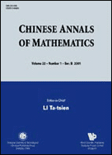
CHINESE ANNALS OF MATHEMATICS SERIES B
Empowering Researchers through Diverse Mathematical DiscoursesCHINESE ANNALS OF MATHEMATICS SERIES B, published by Shanghai Scientific Technology Literature Publishing House, is a prominent journal dedicated to fostering research and development in the field of mathematics. With an ISSN of 0252-9599 and an E-ISSN of 1860-6261, this journal provides a platform for the dissemination of innovative mathematical theories and methodologies. As of 2023, it is categorized within the Q4 quartile in *Applied Mathematics* and has achieved a commendable Q3 rank in *Mathematics (miscellaneous)*, emphasizing its growing influence in academia. Despite not being an open-access publication, it serves as a valuable resource for researchers, professionals, and students seeking to explore diverse mathematical topics, particularly from a unique regional perspective. The journal's extensive publication history—from 1980 and continuing to 2024—demonstrates a longstanding commitment to advancing mathematical knowledge and providing insights into various disciplines related to mathematics.

Journal of Dynamical Systems and Geometric Theories
Fostering Insightful Discourse in Geometric TheoriesJournal of Dynamical Systems and Geometric Theories, published by TARU Publications, is a prominent platform dedicated to advancing knowledge in the fields of dynamical systems and geometric theories. With an ISSN of 1726-037X and an E-ISSN of 2169-0057, this journal serves as a vital resource for researchers, professionals, and students who are keen on exploring the complexities of mathematical models and their applications in various scientific disciplines. Though currently listed as non-open access, the journal provides robust, peer-reviewed content that is essential for fostering innovative research and development. Situated in New Delhi, India, the Journal of Dynamical Systems and Geometric Theories is committed to disseminating high-quality scholarly articles that address both theoretical and practical issues related to dynamical systems, enhancing understanding and stimulating further academic discourse. To learn more about submission guidelines and access options, please visit the journal’s official webpage.
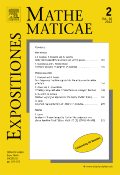
EXPOSITIONES MATHEMATICAE
Exploring Innovative Theories in MathematicsEXPOSITIONES MATHEMATICAE, published by Elsevier GmbH, stands as a significant journal in the realm of mathematics, catering primarily to researchers, professionals, and students. With an ISSN of 0723-0869 and an E-ISSN of 1878-0792, this journal has made its mark in the academic community, boasting a Q2 classification in the miscellaneous mathematics category for 2023, illustrating its prominence within its field. The journal addresses a diverse scope of mathematical topics, encouraging the publication of original research and innovative theories while maintaining rigorous academic standards. As it converges from 2004 to 2024, EXPOSITIONES MATHEMATICAE continues to be an essential resource for advancing mathematical knowledge and fostering scholarly communication, despite being a non-open-access publication. Its location in Munich, Germany further anchors it within a rich intellectual tradition, providing accessibility for the mathematical community worldwide.